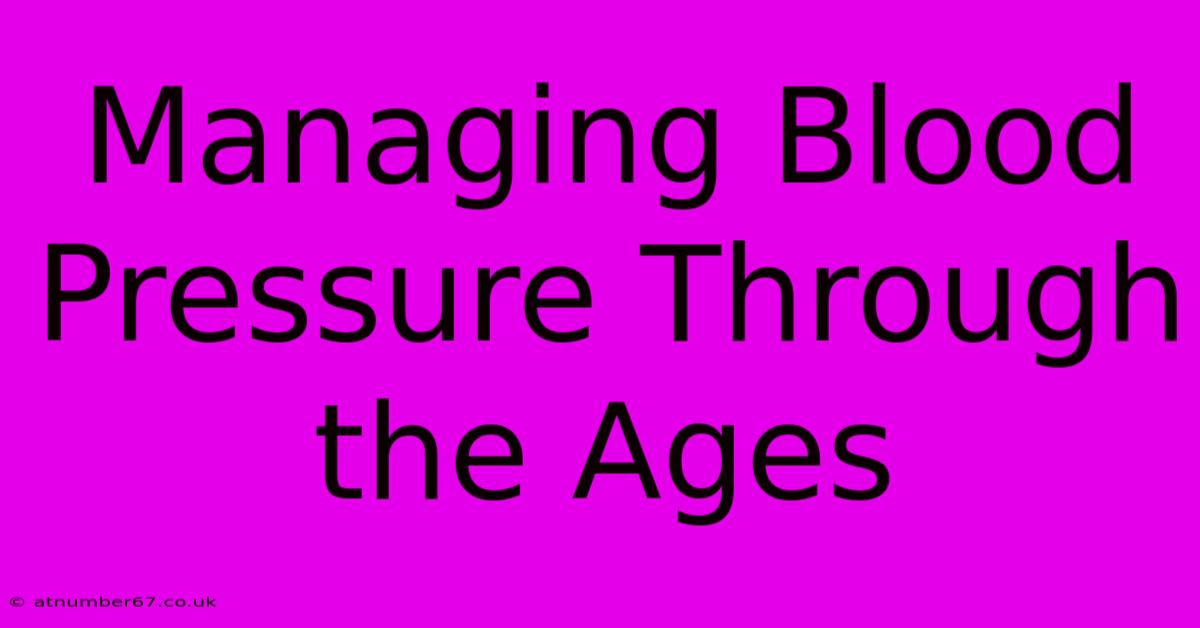Managing Blood Pressure Through The Ages

Table of Contents
Managing Blood Pressure Through the Ages: A Journey Through Time
High blood pressure, or hypertension, is a silent killer that has plagued humanity for centuries. While we now have sophisticated medical interventions, managing blood pressure has evolved dramatically throughout history. This article explores the journey of understanding and treating hypertension, from ancient remedies to modern medicine.
Ancient Approaches to Blood Pressure Management
Long before the invention of sphygmomanometers, civilizations recognized the connection between certain symptoms and what we now understand as hypertension. Ancient texts offer glimpses into their approaches:
Traditional Chinese Medicine (TCM):
TCM emphasized achieving balance within the body. Techniques such as acupuncture, herbal remedies, and dietary modifications aimed to regulate Qi (vital energy) and blood flow, indirectly addressing high blood pressure. Specific herbs believed to lower blood pressure included chrysanthemum and lotus seed.
Ancient Greek and Roman Practices:
The Greeks and Romans recognized the importance of a healthy lifestyle. Dietary restrictions, exercise, and the use of natural remedies like bleeding (phlebotomy – a dangerous practice by modern standards) were common practices. However, the understanding of hypertension as a specific condition was rudimentary.
Ayurvedic Medicine:
Ayurveda, the traditional Indian system of medicine, emphasized a holistic approach. Similar to TCM, it used herbal preparations, yoga, meditation, and lifestyle adjustments to promote overall well-being and potentially mitigate hypertension-related symptoms. Specific herbs and spices like turmeric and ginger are still studied for their potential cardiovascular benefits.
The Rise of Modern Understanding and Treatment
The true understanding of hypertension as a distinct medical condition began to emerge in the 18th and 19th centuries.
The Invention of the Sphygmomanometer (1881):
The development of the sphygmomanometer, a device used to measure blood pressure, marked a pivotal moment. This invention allowed physicians to accurately diagnose and monitor hypertension, paving the way for more targeted treatments.
The 20th Century and Beyond:
The 20th century witnessed significant advancements:
- Lifestyle modifications became increasingly emphasized, including diet changes (reducing sodium intake), regular exercise, weight management, and stress reduction.
- Pharmacological interventions emerged, starting with diuretics and later including beta-blockers, ACE inhibitors, ARBs, and calcium channel blockers, offering various mechanisms to lower blood pressure.
- Improved diagnostic tools such as echocardiography and cardiac CT scans allowed for better assessment of cardiovascular health and identification of underlying causes of hypertension.
Managing Blood Pressure Today: A Multifaceted Approach
Contemporary management of blood pressure is a holistic endeavor:
Lifestyle Changes Remain Crucial:
Dietary adjustments, regular physical activity, stress management techniques, and weight control are cornerstones of successful blood pressure management. A balanced diet rich in fruits, vegetables, and whole grains, low in sodium, saturated fat, and cholesterol is essential.
Medication: A Powerful Tool:
For many individuals, medication is necessary to achieve and maintain healthy blood pressure levels. The choice of medication depends on various factors including individual health conditions, other medications being taken, and the severity of hypertension. Regular monitoring and adjustments are crucial.
The Importance of Regular Monitoring:
Regular check-ups with healthcare professionals are essential. Blood pressure monitoring allows for early detection of problems and timely adjustments to treatment plans. Home monitoring can also help individuals actively participate in their care.
Conclusion: A Continuous Evolution
The management of blood pressure has undergone a remarkable transformation throughout history. From ancient practices that focused on holistic balance to the sophisticated medical interventions of today, we have made significant strides in understanding and treating hypertension. However, maintaining healthy blood pressure remains a continuous journey, requiring a commitment to lifestyle changes, regular medical check-ups, and, when necessary, medication. By understanding the history of managing blood pressure, we can appreciate the progress made and the importance of continuing to prioritize cardiovascular health.

Thank you for visiting our website wich cover about Managing Blood Pressure Through The Ages. We hope the information provided has been useful to you. Feel free to contact us if you have any questions or need further assistance. See you next time and dont miss to bookmark.
Featured Posts
-
Anushka Sharmas Net Worth An Eye Opening Look
Apr 04, 2025
-
Hysen Sons Unwavering Faith
Apr 04, 2025
-
Rachana Rimal Age More Than Meets The Eye
Apr 04, 2025
-
Mahima Chaudhrys Daughters Artistic Talents
Apr 04, 2025
-
Kim Turnbull Age The Publics Perception Vs Reality
Apr 04, 2025
